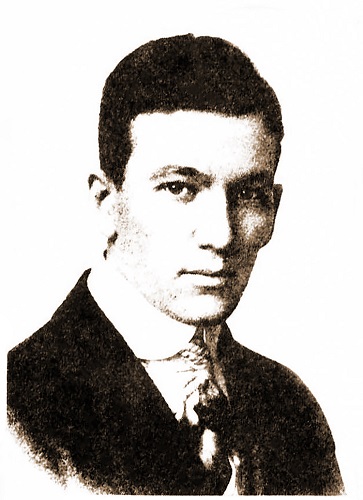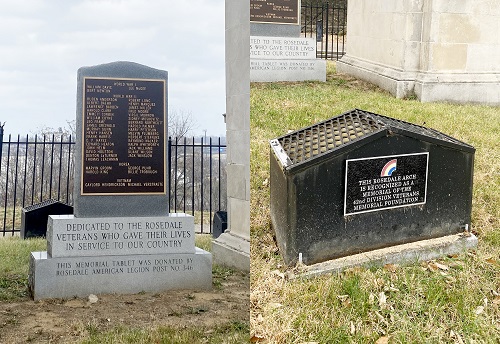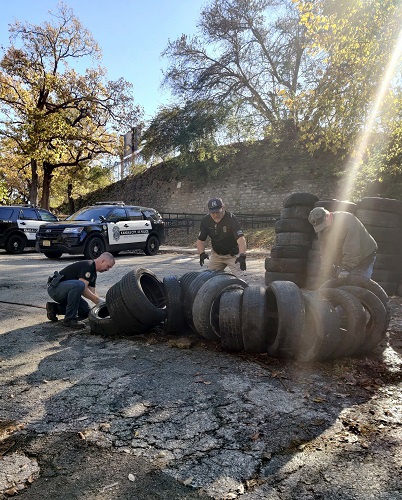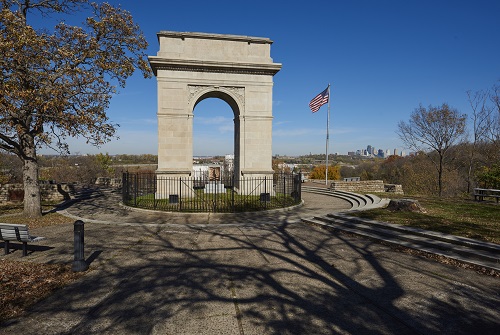What is the History of the Rosedale Memorial Arch? What’s Your KCQ? Investigates

“What’s your KC Q” is a joint project of the Kansas City Public Library and The Kansas City Star. Readers submit questions, the public votes on which questions to answer, and our team of librarians and reporters dig deep to uncover the answers.
Have a question you want to ask? Submit it now »
by Sarah Shoberg | LHistory@KCLibrary.org
When the Sporting Kansas City soccer club released new state line-themed jerseys in February 2022, fans noticed that one of the Nelson-Atkins Museum of Art’s shuttlecock sculptures, along with the Rosedale Memorial Arch, appeared together on the back. A curious reader asked What’s Your KCQ?, a partnership between the Kansas City Public Library and The Kansas City Star, to investigate the history of the arch, and why Sporting chose it to represent Kansas City, Kansas, on the jersey.

In the aftermath of World War I, victorious American troops returned from Europe and patriotism was running high. In 1920, Kansas passed a law allowing public funds to support the construction and installation of military monuments, and the citizens of Rosedale, Kansas, were eager to take advantage of the legislation.
And they knew just the spot.
At the start of the United States’ involvement in the war, the Kansas National Guard had amassed about 350 young men from Rosedale and surrounding communities atop a rocky hilltop overlooking Southwest Boulevard and Turkey Creek. The hilltop was known as Mount Marty in honor of Albert Marty, a real estate developer who had donated the land to the city as a site for Rosedale High School (today’s Rosedale Middle School).
Later, the site took on the name Camp Rushton, for Frank Rushton, a Rosedale baker and civic booster who helped bring in recruits and assisted with their training. Before departing for France, the recruits were inducted into the Army as the 117th Ammunition Train of the 42nd Division, also known as the Rainbow Division. In 1918, while still overseas, Rosedale changed the names of Westport and Hudson avenues to Rainbow Boulevard to honor their service.

Mount Marty was an ideal location to honor Rosedale’s WWI veterans. In June 1921, voters approved a $25,000 bond to build a memorial park and victory arch. Organizers purchased 5.2 acres northwest of the high school for $10,000 and asked John Leroy Marshall, a “Rosedale boy,” to design the arch.
Marshall was not only a local but studied architecture and engineering at the University of Kansas. This, in addition to both his time in service as part of the Army’s 23rd Engineers, a unit that built and repaired battle-damaged roads in France, and his subsequent years in Europe admiring the architecture, made him uniquely qualified to design a memorial.

For a period after the Armistice and before his 1919 return to Kansas, Marshall worked as a courier for the Stars and Stripes newspaper, traveling between Koblenz, Germany, and Paris, France. In his spare time, he filled sketchbooks with drawings of European buildings and monuments. The Arc de Triomphe in Paris, Napoleon Bonaparte’s monument to French soldiers lost during his campaigns, made a distinct impression on him

With the Arc de Triomphe in mind, Marshall designed a limestone arch of “classic proportions.” He included a large tablet reading: “Erected by the people of Rosedale in honor of its citizens who answered their country’s call and served under arms for the triumph of right over might in the World War.”

The 1922 annexation of Rosedale by Kansas City, Kansas, delayed construction while both parties sorted out the legality of the bonds. Finally, Kansas State Representative Louis R. Gates from Wyandotte County brokered a compromise that got the project back on track by 1923.
A parade and groundbreaking ceremony took place on July 20, 1923. KCK Mayor W.W. Gordon declared a half day holiday for the festivities. On the Missouri side, Mayor Frank Cromwell encouraged attendance and asked community members to display flags outside their homes on that day. General Henri Gouraud, the French officer who was assigned to oversee the Rainbow Division during the war, accepted an invitation to attend.
The Wyandotte Post American Legion Drum and Bugle Corps greeted Gouraud at Union Station, and a motorcade escorted him to his hotel where he had breakfast with the Rainbow Division veterans.

Later that day, the parade, watched by an estimated 6,000 people, followed a route on both sides of the state line, traveling along Grand Avenue, Broadway Boulevard, and through Penn Valley Park. At 39th Street, 350 troops from Fort Leavenworth joined the procession on its way to Mount Marty.
A temporary arch welcomed attendees, and a 21-gun salute signaled the start of the groundbreaking ceremony, which featured a ceremonial gold spade, military bands, and 14 dignitaries, including General Gouraud and Kansas Governor Johnathan M. Davis, who delivered speeches.
Construction wrapped the following summer, and 2,500 attendees celebrated the arch’s dedication on September 7, 1924. Camille Parker, daughter of Captain Carl Parker who had served with the Rainbow Division and was active in the Rosedale American Legion Post, unveiled the arch.

Despite the support and fanfare demonstrated at the groundbreaking and dedication ceremonies, over time the arch fell into disrepair. During the Great Depression, the Public Works Administration built an athletic field for Rosedale High School that blocked the monument’s only entrance, furthering its neglect.
Weeds and brush grew unchecked, and portions of the stonework crumbled. KCK officials could not agree who was responsible for maintenance, or even whether the monument was on city property. After years of neglect, city employees began to clear the litter and brush in June 1961.

Robert Jameson, a Rosedale barber and member of the KCK planning commission, wanted the arch restored to its former glory and led a grassroots effort to secure private and public support. The movement gained momentum and resulted in the 1962 formation of the Rosedale Arch Rehabilitation and Endowment Association.
Members of a local bricklayers union volunteered to repair the stonework, others sandblasted the arch, and a North Kansas City contractor provided a bulldozer to create a gravel road leading to the monument. A Veteran’s Day 1962 ceremony rededicated the arch — this time to veterans of all wars.
In 1968, caregivers added floodlights to keep the arch illuminated at night. Camille Parker, who had unveiled the arch in 1924 and attended the 1962 rededication, returned to flip the switch. With renewed interest, a public-private partnership between the KCK parks department and the Rosedale Business Association formed to finance ongoing maintenance and improvements. By 1974, the group had added a paved access road and walkways.

Around 200 people attended the 65th anniversary of the groundbreaking of the arch, which had recently undergone a $30,000 project to restore its façade. In 1993, caretakers added a marker beneath the arch, honoring Rosedale residents killed in World War I, World War II, the Korean War, and the Vietnam War.
Today, the arch and Mount Marty Park are maintained by the Unified Government of Wyandotte County and Kansas City, Kansas’ parks and recreation department. The Rosedale Development Association, an organization devoted to promoting the Rosedale community, organizes volunteer cleanup events and other activities to draw visitors to the site.
Standing high atop the state line area in Mount Marty Park, the Rosedale Memorial Arch has grown into an iconic symbol — not only of the men and women it officially commemorates, but also of KCK — and like the Nelson’s shuttlecocks, it has become an instantly recognizable symbol of Kansas City.
Submit a Question
Do you want to ask a question for a future voting round? Kansas City Star reporters and Kansas City Public Library researchers will investigate the question and explain how we got the answer. Enter it below to get started.